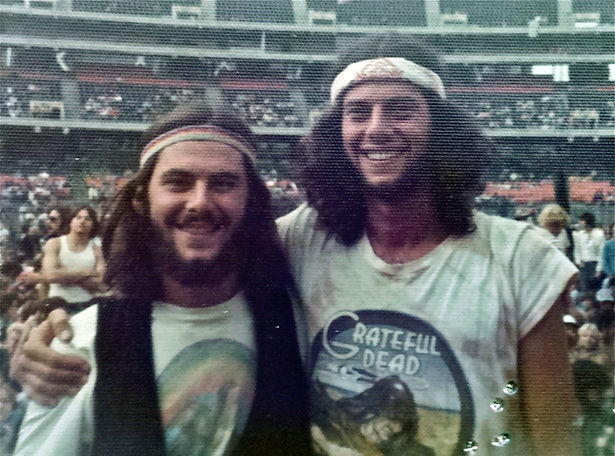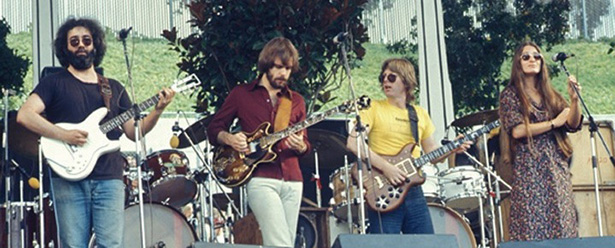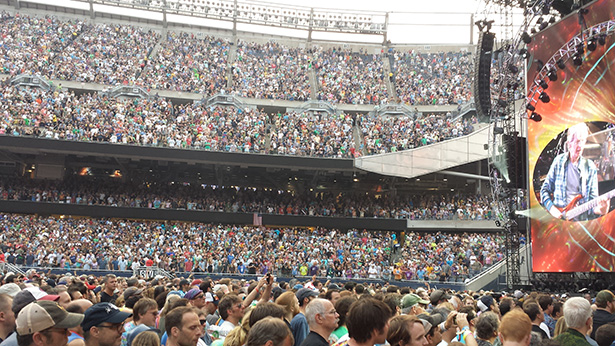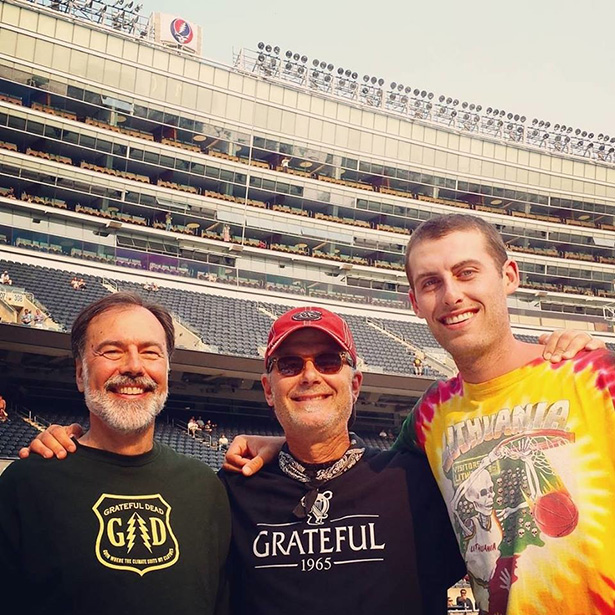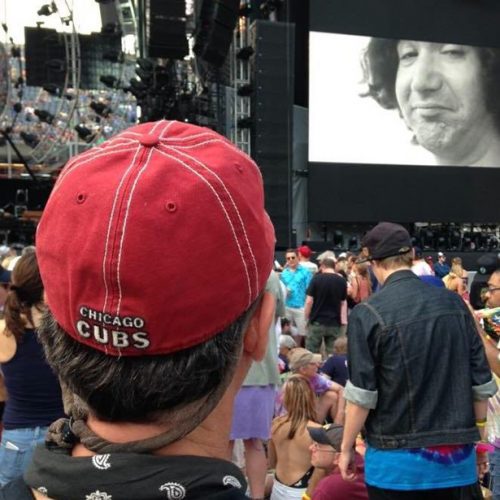
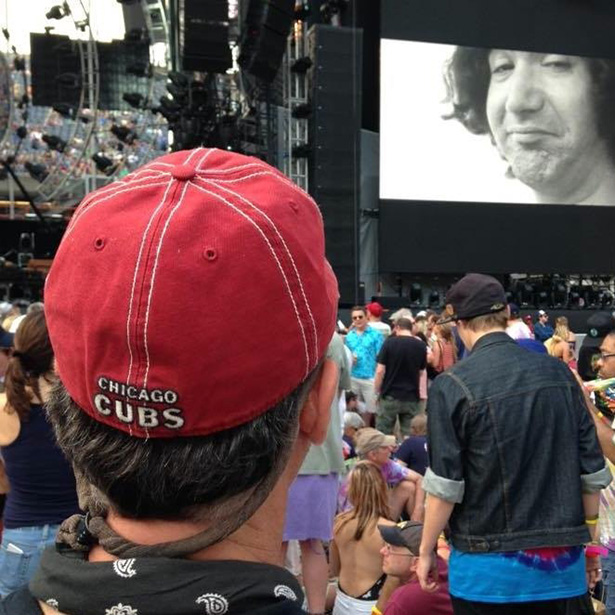 |
| At the July 5 reunion show in Chicago, the author (in baseball cap) with the video monitor showing a young Jerry Garcia (Photo by Nate Wilson-Traisman) |
The Southwest plane taxied on the runway as “Good Lovin’” blared through the sound system. The flight attendant playing with us, asked if any of us were here to see the shows and the passengers let out a collective hoot and holler. We were officially welcomed to Chicago. The Grateful Dead was the main attraction in the city of big shoulders, my birthplace, over Independence Day weekend. Last week I returned home with my 27-year-old son (born on the Fourth of July) and my brother and his oldest high school friend, almost 39 years to the day of our first Dead show June 26, 1976 at Chicago’s Auditorium Theater.
In January when the “Fare Thee Well” tour was announced it was a certainty that my brother, son and I would make the trip home. How could we not? Accommodations? Tickets? Mere details to be ironed out later. After initial rejection on our mail orders, fate and good fortune befell us and we landed pit tickets for all three shows.
As I write this, the infinite stories and angles about the meaning of this epic goodbye in Santa Clara and Chicago have been as thoroughly mined as California during the gold rush. This small reflection is my contribution.
Nov. 1, 1973, the night before my 17th birthday and the Grateful Dead is playing at McGaw Hall on the campus of Northwestern University. I’m at the Allman brothers concert at Chicago Stadium. Same town, same night, a choice had to be made.
Nearly three years later in the summer of 1976 I was at a life-changing intersection. During my second year of college in Illinois I took a six-week “independent study” road trip west and spent a month in Cottage Grove with my older brother who was living in the Cerro Gordo community (I was to return with a paper on his intentional community). That trip changed me and I returned in the early months of 1976 determined to find my way west as soon as possible. By that summer I was plotting my course when it was announced the Grateful Dead would be playing four shows at the Auditorium Theater at the end of June. I had seen Jerry twice in 1975 and ’76 when the band was on hiatus. Now was my time.
Those four nights are their own story, especially the final night when roaming on my own in the dawns early hours, I had a phone conversation with Jerry from his hotel room in Chicago’s Whitehall. I called, asked for his room, he answered, we talked. From my end I was trying to string together a few words about the deeper message of the band’s music and Jerry reminded me (as he was prone to do): no message intended, just good times and music.
It wasn’t until some months later when I heard Jerry in a radio interview that I could be 100 percent certain that what I believed had happened had actually happened. There was no internet to do quick fact checks. Things took more time. Mystery lasted longer. Two months later I was living in Flagstaff, Arizona, where I graduated from Northern Arizona University in 1978. In 1981 I moved to Seattle, began my teaching career, made a family and moved to Eugene in 1993. Other than annual summer vacations I never lived in Chicago again, and I never saw the Grateful Dead in Chicago again.
Across the years I saw the Dead a lot less than most Deadheads. My shows only numbered in the lower double digits. But returning home to Chicago was a must. My brother was on board, my son was on board and Summer Andy (I’m a school teacher) was definitely on board!
The shows were extraordinary but the critique of songs played and songs left out, a concert review, is not my story. My story is my fascination at how this band that were such counter-culture outliers, as far from the mainstream as a band could be, choreographed the unimaginable “Fare Thee Well” shows I saw in Chicago. The airplane was just the beginning. Everywhere we went, from bars and restaurants, trains and taxis, Wrigley Field to the Field Museum, we were greeted like royalty. Where once a tie-dyed shirt in Chicago might be met with derision, now it was as if we were wearing Joseph’s Technicolor raincoat! We met people from all over the country and world, all like us, among the lucky few with an invitation to the party. The president of the United States invited the band to the White House, newspapers all over the country chronicled the concerts on their front page, people attended live streams wherever available and we tossed beach balls with Bill Walton.
“Strangers stopping strangers just to shake their hand.” John from Durango, Craig from Salt Lake, Jim from Indiana, Kevin from Miami, brother Mark from San Rafael — countless others at the show, on the streets, on the beach including that amazing kid who came from Japan whose name we never really got. Coming back home to find the bookend to what my brother and I began 39 years ago and share it with him and my boy (my daughter loves the band but not the jams).
In the end, Mickey Hart, one of the original “core four,” talked to us about carrying the feeling we had out into the world. He closed with the words “Be kind.” Take it, hold it, spread it. The music never stops. But that isn’t the only takeaway. As a classroom teacher for near 30 years, I’ve learned to distinguish between what matters most, and what is the onerous impositions of those who truly don’t know better.
Twenty years after Jerry Garcia’s death, what was left of The Grateful Dead marked their 50th birthday by coming back to Chicago to say “Fare Thee Well” the way they wanted to, on their terms. The once outliers we’re traveling the center line of the mainstream, and whether you love, like or loath their music, they peaked in their cultural significance and for a brief and shining moment captured the collective spotlight. May we all have the chance to express our fullest passion on our own terms.
“Fare and be well now, let your life proceed by its own design. Nothing to tell now, let your words be yours, I’m done with mine.” — Andy Traisman
